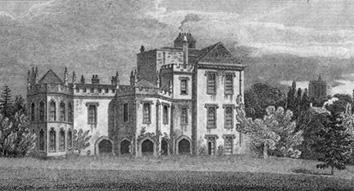Nottingham by the Sea
1817 - 2017
The 200th Anniversary of the start of mechanical lace making in Calais using a Levers loom smuggled from Nottingham
In 1816 when Nottingham was the world leader in lace manufacturing, three Nottingham men (Clark, Bonington and Webster) dismantled a Levers loom and smuggled the parts to Calais, where it was reassembled. In doing so they risked transportation to Australia, because the movement of skilled artisans abroad and the exportation of machinery were strictly forbidden until 1824 and 1843, respectively. Others quickly followed from all over the East Midlands, bringing their skills and knowhow with them. So, from this small precarious beginning, a vibrant Anglo-Calaisian lace manufacturing industry flourished in Calais, which still exists today, albeit on a much reduced scale.
The English ‘colony’ in Calais once numbered many thousands, complete with Anglican and Methodist churches, English schools, cricket clubs, shops, pubs, doctors, undertakers, performances of Gilbert and Sullivan operas and an English language newspaper. East Midland lace manufacturing terminology was adopted by the French, as were the traditions and practices of East Midland lace workers and factory owners. Calais is the only town in France, where plum pudding is (still) served on Christmas Day!
All this came to an abrupt end in May 1940, when the Nazis invaded France. What remained of the English colony in Calais fled to Great Britain.
Les Rêves de Notre-Dame de Calais
The performance of English choral music by the Choir of Saint Mary’s Church Nottingham on 11 November 2017, forms part of the annual musical weekend, Les Rêves de Notre-Dame de Calais (The Dreams of Our-Lady of Calais).
It is also part of an initiative to renew the historic ties that once existed between Nottingham and Calais. If you would like to know more about this, please contact Philip Emerson at pejemerson@gmail.com
1817 - 2017
200ème Anniversaire du début de la fabrication mécanique de la dentelle à Calais à l'aide d'un métier Leavers passé en contrebande de Nottingham
Calais était autrefois connue en Grande-Bretagne comme « Nottingham-sur-Mer » en raison de ses liens étroits avec la fabrication de tulle à Nottingham.
En 1816, alors que Nottingham était le leader mondial de la fabrication de tulle, trois hommes de Nottingham (Clark, Bonington et Webster) démontèrent un métier Leavers et passèrent clandestinement les pièces à Calais, où il fut remonté. En faisant ceci, ils risquaient d'être transportés en Australie, car les déplacements d'artisans qualifiés à l'étranger et l'exportation de machines étaient strictement interdits jusqu'en 1824 et 1843 respectivement. D'autres artisans de la région des East Midlands les ont rapidement suivis apportant leurs compétences et leur savoir-faire. Ainsi, à partir de ce petit début précaire, s’est développée à Calais une industrie de fabrication de tulle anglo-calaisienne dynamique et prospère, qui existe encore aujourd'hui, mais à une échelle beaucoup plus réduite.
La ‘colonie’ anglaise à Calais comptait plusieurs milliers de personnes, et avait ses propres églises , anglicanes et méthodistes, ses écoles anglaises, ses clubs de cricket, ses boutiques, ses pubs, ses médecins, ses pompes funèbres, ses représentations d’opéras de Gilbert et Sullivan et son journal anglophone. La terminologie de la fabrication de tulle des East Midlands a été adoptée par les Français, tout comme les traditions et les pratiques des dentellières et des propriétaires d'usine de cette région d’Angleterre. Calais est la seule ville de France où le pudding aux prunes est (encore) servi le jour de Noël !
Tout cela a brusquement pris fin en mai 1940, lorsque les Nazis ont envahi la France. Ce qui restait de la colonie anglaise à Calais s'est enfui en Grande-Bretagne.
Les Rêves de Notre-Dame de Calais
L'interprétation de la musique chorale anglaise par le Chœur de l'église Sainte-Marie de Nottingham, le 11 novembre 2017, s’inscrit dans le week-end musical annuel, Les Rêves de Notre-Dame de Calais.
Elle s’inscrit également dans une initiative visant à renouveler les liens historiques qui existaient autrefois entre Nottingham et Calais. Si vous souhaitez en savoir plus sur ce sujet, veuillez contacter Philip Emerson à pejemerson@gmail.com
Escape from Calais
The evacuation of British citizens from Calais by HMS Venomous on 21 May 1940
L'évacuation des citoyens britanniques de Calais par les V & W
A Hard Fought Ship
Buy the new hardback edition online for £29post free in the UK
Take a look at the Contents Page and List of Illustrations

http://holywellhousepublishing.co.uk
Telephone: +44 1727 838595
contact online
Enregistrer
